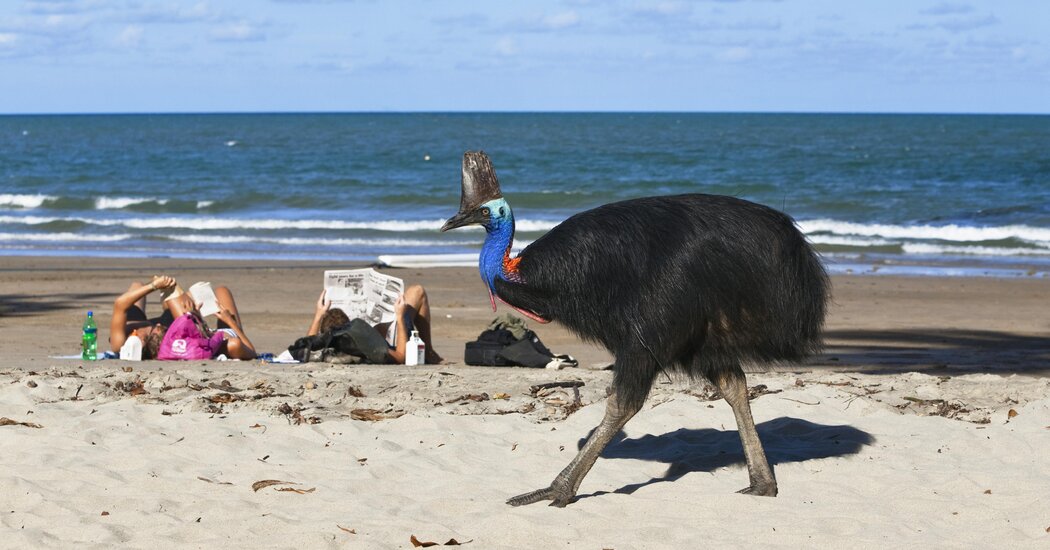Combating The Killer Seaweed: Protecting Australia's Marine Life

Table of Contents
Understanding the Impact of Invasive Seaweed
Invasive seaweed, such as Caulerpa taxifolia and Undaria pinnatifida, poses a significant threat to Australia's marine ecosystems. Their rapid growth and spread have far-reaching ecological and economic consequences.
-
Ecological Consequences: Invasive seaweeds outcompete native flora, leading to biodiversity loss and habitat destruction. This disrupts the delicate balance of the marine ecosystem, impacting food webs and the survival of numerous species. The loss of seagrass beds, crucial habitats for many marine animals, is a particularly devastating consequence of invasive seaweed proliferation.
-
Economic Impacts: The spread of killer seaweed significantly impacts Australia's economy. Damage to fisheries, reduced tourism revenue due to degraded coastal areas, and the costs associated with control and management efforts all contribute to a substantial financial burden. For instance, the impact on aquaculture industries, where seaweed can smother shellfish and fish farms, is considerable.
-
Affected Areas: Invasive seaweed infestations have been reported across various Australian coastal regions, including areas of New South Wales, Victoria, South Australia, and Western Australia. These infestations threaten popular tourist destinations and ecologically sensitive areas.
Current Methods for Combating Invasive Seaweed
Combating the spread of killer seaweed requires a multi-pronged approach, utilizing various control methods.
2.2.1 Mechanical Removal
Mechanical removal involves physically removing the seaweed through methods such as dredging or hand-pulling. While effective in localized areas and for small infestations, this approach has limitations.
- Limitations: It's often costly, labor-intensive, and can be environmentally disruptive, particularly if not done carefully. It's also not scalable for large infestations.
2.2.2 Chemical Control
Chemical control utilizes herbicides to eliminate invasive seaweed. However, this method carries inherent risks.
- Environmental Risks: Herbicide application must be carefully managed to minimize harm to non-target species and the wider marine environment. Strict regulations and environmental risk assessments are crucial. Sustainable seaweed control requires a cautious and precise approach to herbicide use.
2.2.3 Biological Control
Biological control involves introducing natural predators or pathogens to control invasive seaweed populations. This is a promising area of research.
- Ongoing Research: Scientists are actively investigating potential biological control agents, but this approach requires careful study to ensure it doesn't inadvertently create new ecological problems. The development of effective biological control requires significant research and careful risk assessment.
Prevention and Early Detection Strategies
Preventing the introduction and spread of invasive seaweed is paramount. Proactive measures are crucial in minimizing future infestations.
-
Biosecurity Measures: Strict biosecurity measures at ports and harbors are vital to prevent the introduction of new invasive species through ballast water or on ship hulls. Robust quarantine protocols are essential.
-
Early Detection Programs: Rapid response to early detections of invasive seaweed is key to containing outbreaks before they become widespread. Regular monitoring programs and effective surveillance strategies are necessary.
Community Involvement and Citizen Science
Community involvement is crucial in combating killer seaweed. Citizen science initiatives play a significant role in effective control strategies.
-
Seaweed Reporting: Encouraging community members to report suspected sightings of invasive seaweed allows for rapid response and targeted control efforts. Many successful community programs in Australia rely on this crucial element of early detection.
-
Community Monitoring: Citizen scientists can participate in monitoring programs, collecting valuable data on the spread and impact of invasive seaweed, contributing to a comprehensive understanding of the problem and improving management strategies.
Conclusion: Protecting Australia's Marine Life from the Threat of Killer Seaweed
Invasive seaweed poses a severe threat to Australia's marine ecosystems, impacting biodiversity, damaging habitats, and creating significant economic consequences. A multi-faceted approach, encompassing mechanical, chemical (when appropriate and strictly regulated), and biological control methods, coupled with robust prevention strategies and active community engagement, is vital to combat this challenge. Early detection and rapid response, facilitated by community reporting and citizen science initiatives, are crucial. Let's work together to protect our precious marine environment from the threat of killer seaweed. Learn more about invasive seaweed identification, report sightings to your local authorities, and support organizations dedicated to marine conservation. Together, we can safeguard Australia’s unique and valuable marine biodiversity. Visit [link to relevant organization 1] and [link to relevant organization 2] to learn more and get involved.

Featured Posts
-
 Could A Beloved Nissan Classic Car Be Returning
May 30, 2025
Could A Beloved Nissan Classic Car Be Returning
May 30, 2025 -
 Benicio Del Toros Gift A Comprehensive Analysis Of A Carefully Crafted Scheme
May 30, 2025
Benicio Del Toros Gift A Comprehensive Analysis Of A Carefully Crafted Scheme
May 30, 2025 -
 Revolucionando La Compra De Entradas Ticketmaster Introduce Virtual Venue
May 30, 2025
Revolucionando La Compra De Entradas Ticketmaster Introduce Virtual Venue
May 30, 2025 -
 Monte Carlo Masters Alcaraz Defeats Musetti For Maiden Title
May 30, 2025
Monte Carlo Masters Alcaraz Defeats Musetti For Maiden Title
May 30, 2025 -
 Unlocking The Mysteries Of Whidbey Clams Through Citizen Science
May 30, 2025
Unlocking The Mysteries Of Whidbey Clams Through Citizen Science
May 30, 2025
Latest Posts
-
 Sukces Flowers Jak Nowy Singiel Miley Cyrus Zapowiada Jej Nowa Plyte
May 31, 2025
Sukces Flowers Jak Nowy Singiel Miley Cyrus Zapowiada Jej Nowa Plyte
May 31, 2025 -
 Flowers Debiutancki Singiel Miley Cyrus Z Nowej Plyty Pelna Analiza
May 31, 2025
Flowers Debiutancki Singiel Miley Cyrus Z Nowej Plyty Pelna Analiza
May 31, 2025 -
 Premiera Singla Flowers Czy Miley Cyrus Zmienia Kierunek
May 31, 2025
Premiera Singla Flowers Czy Miley Cyrus Zmienia Kierunek
May 31, 2025 -
 Recenzja Singla Flowers Miley Cyrus Zapowiedz Nowej Ery Muzycznej
May 31, 2025
Recenzja Singla Flowers Miley Cyrus Zapowiedz Nowej Ery Muzycznej
May 31, 2025 -
 Flowers Miley Cyrus Analiza Pierwszego Singla Z Nadchodzacej Plyty
May 31, 2025
Flowers Miley Cyrus Analiza Pierwszego Singla Z Nadchodzacej Plyty
May 31, 2025
